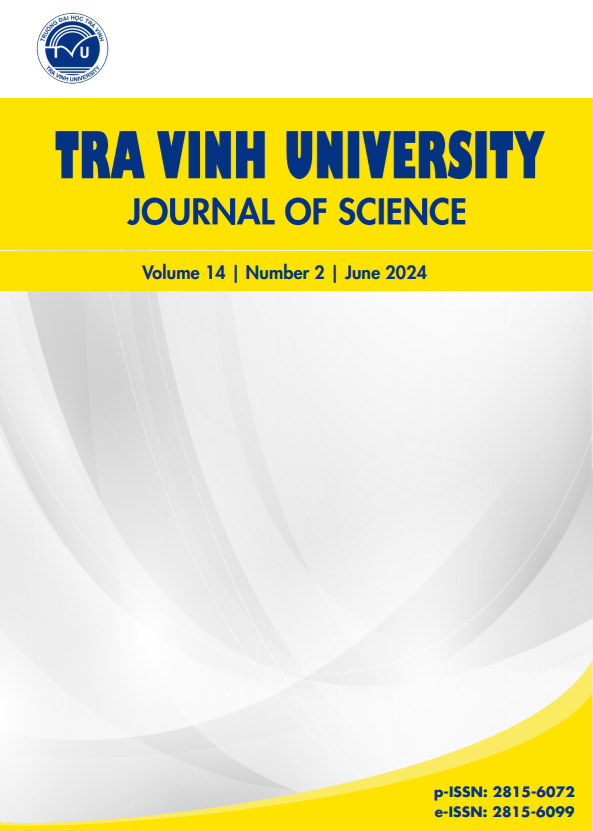OVERVIEW OF THE CANINE PARVOVIRUS TYPE 2: ETIOLOGY, PATHOGENESIS, DIAGNOSIS, TREATMENT, AND PREVENTION
Abstract
Parvo in dogs is caused by canine parvovirus type 2 (CPV-2), a highly contagious viral disease in dogs that often causes high mortality and is mainly transmitted through the gastrointestinal tract. Nowadays, the variants identified include CPV-2a, CPV-2b, and CPV-2c. This pathogen has appeared in most countries around the world, including Vietnam. Its host range varies with each type of variant, and its relative frequency and genetic variability also vary between countries. The research provides an overview of key information regarding the
molecular structure, origin, evolution, and pathophysiology of CPV-2, drawing on 30 published study results from various countries worldwide. This paper helps to identify risk factors that contribute to CPV-2 disease. In addition, the research also synthesizes research on advanced diagnosis, treatment, and CPV-2 vaccine development, serving as a basis for veterinarians, veterinary students, and breeders to control and limit the impact of upper enteritis caused by CPV-2.
-- PDF Article: https://drive.google.com/file/d/1ah4LKB4Hr1V1BiXSzSgKTinyDLei77RJ/view?usp=sharing
Downloads
References
Parvoviral enteritis and panleukopenia in dogs. Veterinary Medicine & Small Animal Clinician. 1979:74(1):
47–50.
[2] Miranda C, Thompson G. Canine parvovirus: the
worldwide occurrence of antigenic variants. Journal of General Virology. 2016;97(9): 2043–2057.
http://doi.org/10.1099/jgv.0.000540.
[3] Tavora F, Gonzalez-Cuyar LF, Dalal JS, O’Malley
MT, Zhao R, Peng HQ, et al. Fatal parvoviral myocarditis: A case report and review of the
literature. Diagnostic Pathology. 2008;3(1): 1–6.
http://doi.org/10.1186/1746-1596-3-21.
[4] Nandi S, Kumar M, Mohapatra TK, Ravishankar
C. Emergence of canine parvovirus-2 variants and
its impact on vaccination. World Applied Sciences
Journal. 2013;23(10): 1366–1376.
[5] Bull JJ. Evolutionary reversion of live viral vaccines:
Can genetic engineering subdue it? Virus Evolution.
2015;1(1): 1–10. https://doi.org/10.1093/ve/vev005.
[6] Mylonakis M, Kalli I, Rallis T. Canine
parvoviral enteritis: an update on the clinical
diagnosis, treatment, and prevention. Veterinary
Medicine: Research and Reports. 2016;7: 91–100.
http://doi.org/10.2147/VMRR.S80971.
[7] Nelson CDS, Minkkinen E, Bergkvist M, Hoelzer K,
Fisher M, Bothner B, et al. Detecting small changes
and additional peptides in the canine parvovirus
capsid structure. Journal of Virology. 2008;82(21):
10397–10407. http://doi.org/10.1128/JVI.00972-08.
[8] Tagorti G. Prevalence of canine parvovirus infection in Grand Tunis, Tunisia. Journal of Advanced
Veterinary and Animal Research. 2018;5(1): 93–97.
http://doi.org/10.5455/javar.2018.e251.
[9] Ogbu KI, Anene BM, Nweze NE, Okoro JI, Danladi
MMA, Ochai SO. Canine parvovirus: a review. International Journal of Science and Applied Research.
2017;2(2): 74–95.
[10] Callaway HM, Feng KH, Lee DW, Allison AB, Pinard
M, McKenna R, et al. Sandri-Goldin RM (eds.).
Parvovirus capsid structures required for infection:
mutations controlling receptor recognition and protease cleavages. Journal of Virology. 2017;91(2): 1–
16. http://doi.org/10.1128/JVI.01871-16.
[11] Kang JI, Park NY, Cho HS. Detection of canine parvovirus in fecal samples using loopmediated isothermal amplification. Journal of Veterinary Diagnostic Investigation. 2006;18(1): 81–84.
http://doi.org/10.1177/104063870601800111.
[12] Truyen U. Evolution of canine parvovirus
– A need for new vaccines? Veterinary Microbiology. 2006;117(1): 9–13.
http://doi.org/10.1016/j.vetmic.2006.04.003.
[13] Decaro N, Buonavoglia C. Canine parvovirus—a
review of epidemiological and diagnostic
aspects, with emphasis on type 2c.
Veterinary Microbiology. 2012;155(1): 1–12.
https://doi.org/10.1016/j.vetmic.2011.09.007.
[14] Ford J, McEndaffer L, Renshaw R, Molesan
A, Kelly K. Parvovirus infection is associated with myocarditis and myocardial fibrosis in young
dogs. Veterinary Pathology. 2017;54(6): 964–971.
http://doi.org/10.1177/0300985817725387.
[15] Geetha M. Epidemiology, pathogenesis, clinical findings and diagnosis of canine parvo viral infection–a
mini review. International Journal of Scientific Engineering and Applied Science. 2015;1(9): 21–27.
[16] Tuteja D, Banu K, Mondal B. Canine parvovirology–A brief updated review on structural biology,
occurrence, pathogenesis, clinical diagnosis, treatment and prevention. Comparative Immunology, Microbiology and Infectious Diseases. 2022;82: 101765.
http://doi.org/10.1016/j.cimid.2022.101765.
[17] Prittie J. Canine parvoviral enteritis: A review
of diagnosis, management, and prevention. Journal of Veterinary Emergency and Critical Care.
2004;14(3): 167–176. http://doi.org/10.1111/j.1534-
6935.2004.04020.x.
[18] Nandi S, Kumar M. Canine Parvovirus: current perspective. Indian Journal of Virology. 2010;21(1): 31–
44. http://doi.org/10.1007/s13337-010-0007-y.
[19] Sharma S, Dhar P, Sharma M. Study of different risk factors for canine parvovirus infection by
haemagglutination assay. Journal of Animal Research.
2019;9(5): 735–739.
[20] Hematian A, Sadeghifard N, Mohebi R, Taherikalani
M, Nasrolahi A, Amraei M, et al. Traditional and
modern cell culture in virus diagnosis. Osong Public
Health and Research Perspectives. 2016;7(2): 77–82.
https://doi.org/10.1016/j.phrp.2015.11.011.
[21] Lambe U, Guray M, Bansal N, Kumar P, Joshi
VG, Khatri R, et al. Canine parvovirus-an insight
into diagnostic aspect. Journal of Experimental Biology and Agricultural Sciences. 2016;4(3S): 279–290.
http://dx.doi.org/10.18006/2016.4(3S).279.290.
[22] Van Schoor M, Schoeman JP. Early
enteral nutrition in puppies with parvovirus
enteritis. Vet Nurse. 2014;5(8): 434–440.
http://doi.org/10.12968/vetn.2014.5.8.434.
[23] Gonuguntla HN, Surendra K, Rana SK, Ponnanna
NM, Subramanian BM, Sharma GK, et al.
Detection and typing of CPV with real-time
PCR and mini sequencing. Advances in Animal
and Veterinary Sciences. 2016;4(4): 187–194.
http://dx.doi.org/10.14737/journal.aavs/2016/4.4.187.194.
[24] Wang J, Liu L, Li R, Wang J, Fu Q, Yuan
W. Rapid and sensitive detection of canine parvovirus type 2 by recombinase polymerase amplification. Archives of Virology. 2016;161(4): 1015–1018.
http://doi.org/10.1007/s00705-015-2738-y.
[25] Rerksuppaphol S, Rerksuppaphol L. Efficacy of intravenous ondansetron to prevent vomiting episodes in
acute gastroenteritis: a randomized, double blind, and
controlled trial. Pediatric Reports. 2010;2(2): 55–57.
https://doi.org/10.4081/pr.2010.e17.
[26] Tenne R, Sullivan LA, Contreras ET, Olea-Popelka
F, Twedt DC, Fankhauser J, et al. Palatability and
clinical effects of an oral recuperation fluid during the
recovery of dogs with suspected parvoviral enteritis.
Topics in Companion Animal Medicine. 2016;31(2):
68–72. https://doi.org/10.1053/j.tcam.2016.08.001.
[27] Kilian E, Suchodolski JS, Hartmann K, Mueller RS,
Wess G, Unterer S. Long-term effects of canine
parvovirus infection in dogs. PloS One. 2018;13(3):
1–11. https://doi.org/10.1371/journal.pone.0192198.
[28] Vasu J, Srinivas MV, Antony PX, Thanislass
J, Padmanaban V, Mukhopadhyay HK. Comparative immune responses of pups following modified live virus vaccinations against canine parvovirus. Veterinary World. 2019;12(9): 1422–1427.
http://doi.org/10.14202/vetworld.2019.1422-1427.
[29] Decaro N, Buonavoglia C, Barrs VR. Canine
parvovirus vaccination and immunisation
failures: Are we far from disease eradication?
Veterinary Microbiology. 2020;247: 108760.
https://doi.org/10.1016/j.vetmic.2020.108760.
[30] Hao X, Li Y, Xiao X, Chen B, Zhou P,
Li S. The changes in canine parvovirus
variants over the years. International Journal
of Molecular Sciences. 2022;23(19): 11540.
http://doi.org/10.3390/ijms231911540/.









